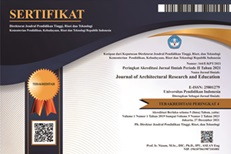TRANSFORMATION OF TRADITIONAL SETTLEMENTS AND DISASTER VULNERABILITY
Abstract
As a setting of life and cultural products made by humans, settlements always undergo transformation along with the dynamics of their inhabitants’ lives. The dynamics of occupants, in addition to being impacted by the development of local knowledge, changes in the way humans respond to climate, and cultural transformation, are also influenced by external factors. External factors that influence settlement transformation can arise in the form of urbanisation, changes in social and political systems, economics, and technological development. In traditional societies, natural threats are predictable and conquerable. The transformation of settlements can take place in the same frame, promoting natural considerations, or in a different frame with the existence of new ideas and knowledge and technology coming from the outside. To be able to understand the transformation of traditional settlements and their transformations in relation to disaster vulnerability, this paper evaluated the causing factors, patterns, and consequences resulted from the transformation of settlements. For this reason, urban morphological studies are applied as an evaluation method. The results of the evaluation of settlement transformations reveal that traditional settlements are farther away leaving natural-harmony patterns at the root of their existence. Economic approach has replaced the cosmological-based settlement. It is recommended that natural site characteristic should be taken into consideration in order to avoid natural disaster in the future. This means that the traditional approach is still relevant in contemporary situation.
Keywords: Traditional settlements; transformation; disaster vulnerablity
Full Text:
PDFReferences
Boeing, G. (2018). Measuring the complexity of urban form and design. Urban Design International, 23, 281-292.
Bourdier, J., & Alsayyad, N. (1989). Dwellings, settlements and tradition: Cross-cultural perspectives. Lanham: University of Minnesota.
Carmona, M. (2019). Place value: place quality and its impact on health, social, economic and environemntal outcomes. Journal of Urban Design, 24(1), 1-48.
Dias, N., Keriminiyage, K., Amaratunga, D., & Curwell, S. (2018). Crtitical success factors of a bottom up urban design process to deliver sustainable urban design. International journal of Strategic Property Management, 22(4), 265-277.
Hudalah, D., & Woltjer, J. (2007). Spatial planning system in Indonesia. International Planning Studies, 12(3), 291-303.
King, A. D. (1991). Culture, globalisation and the world system: contemporary conditions for the representations. London: Palgrave MacMillan.
Kropf, K. (2009). Aspect of urban form. Urban Morphology, 13(2), 105-120.
Muhammad, N. M., Saruwono, M., Said, S. Y., & Hariri, W. A. (2013). A sense of place within the landscape in cultural settings. Asia Pacific International Conference on Environmental-Behaviour Studies (hal. 506-512). London: Procedia-Social and Behavioral Science.
Oliver, P. (2007). Dwellings: the vernacular house worldwide. London: Phaidon Press.
Participation, I. A. (2019, December 2). Spectrum of Public Participation. Dipetik 2019, dari International Association for Public Participation: https://cdn.ymaws.com/www.iap2.org/resource/resmgr/pillars/Spectrum_8.5x11_Print.pdf
Permana, A. Y. (2014). Transformasi Gubahan Ruang: Pondokan Mahasiswa di Kawasan Balubur Tamansari Kota Bandung (Universitas Diponegoro). Retrieved from http://eprints.undip.ac.id/62084/
Sinamides, J. F. (2017). Transformation of vernacular architecture of the mountainous settlements of pomaks in Xanthi, Greece. Journal of the International Society for the Study of Vernacular Settlements, 5(1), 1-16.
Tjahjono, G., & Miksic, J. N. (2003). Architecture: The Indonesian Heritage Series. Singapore: Archipelago Press.
Waterson, R. (1997). The Living House: An Anthropology of Architecture in South-east Asia (Paperback ed.). Singapore: Oxford University Press.
Watson, G. B., & Bentley, I. (2007). Identity by Design. London: Architectural Press.
Zhang, M., Wu, W., & Zhong, W. (2018). Agency and social construction of space under top-down planning: Resettled rural residents in China. Urban Studies, 55(7), 1541-1560.
DOI: https://doi.org/10.17509/jare.v2i1.22076
Refbacks
- There are currently no refbacks.
Copyright (c) 2020 I Nyoman Gede Maha Putra

This work is licensed under a Creative Commons Attribution-NonCommercial-ShareAlike 4.0 International License.

This work is licensed under a Creative Commons Attribution-ShareAlike 4.0 International License.








